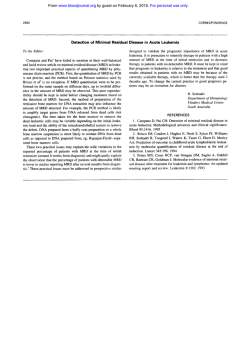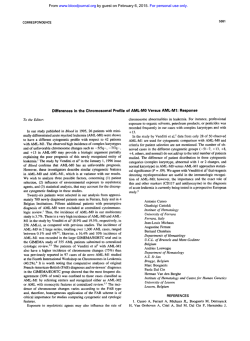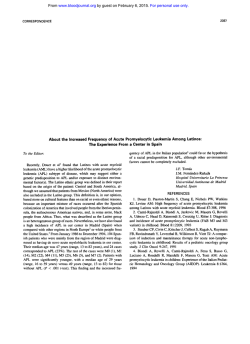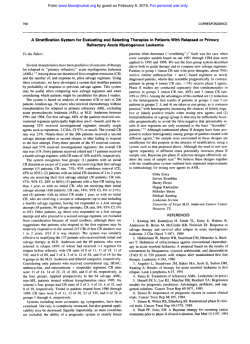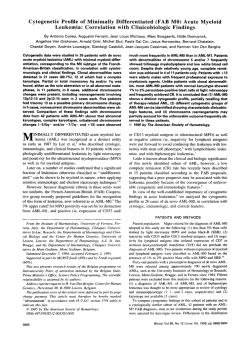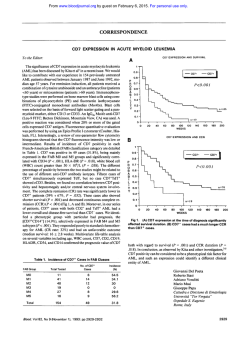
Evidence-Based Focused Review of Minimal Residual
From www.bloodjournal.org by guest on February 6, 2015. For personal use only. Blood First Edition Paper, prepublished online January 28, 2015; DOI 10.1182/blood-2014-11-578815 KAYSER et al. MRD-Directed Therapy in AML Evidence-Based Focused Review of Minimal Residual Disease-Directed Therapy in Acute Myeloid Leukemia Short title: MRD-Directed Therapy in AML Sabine Kayser,1 Richard F. Schlenk,2 David Grimwade,3 Victor E.D. Yosuico,4 Roland B. Walter5,6,7 1 Department of Internal Medicine V, University Hospital of Heidelberg, Heidelberg, Germany; 2Department of Internal Medicine III, University Hospital of Ulm, Ulm, Germany; 3Department of Medical & Molecular Genetics, King’s College London, Faculty of Life Sciences and Medicine, UK; 4 Buffalo Medical Group, Buffalo, NY, USA; 5 Clinical Research Division, Fred Hutchinson Cancer Research Center, Seattle, WA, USA; 6Department of Medicine, Division of Hematology, University of Washington, Seattle, WA, USA; 7Department of Epidemiology, University of Washington, Seattle, WA, USA Correspondence: Sabine Kayser, MD; Department of Internal Medicine V; University Hospital of Heidelberg; Im Neuenheimer Feld 410; 69120 Heidelberg, Germany Phone: +49-6221-56-37763, Fax: +49-6221-56-5723 E-mail: [email protected] 1 Copyright © 2015 American Society of Hematology From www.bloodjournal.org by guest on February 6, 2015. For personal use only. KAYSER et al. MRD-Directed Therapy in AML CASE PRESENTATIONS Case 1. A 35-year-old man with normal white blood cell (WBC) count (9.3 x 109/L) was diagnosed with acute myeloid leukemia (AML) with a t(8;21)(q22;q22) translocation in 25/25 metaphases. The RUNX1-RUNX1T1 fusion gene was detected by real-time quantitative polymerase chain reaction (RT-qPCR), whereas studies for mutations involving KIT and FLT3 were negative. After one cycle of induction therapy with cytarabine/idarubicin according to the “7+3” schema, he achieved a morphological complete remission (CR) with a 2-log reduction of RUNX1-RUNX1T1 transcript levels. The patient has an excellent performance status and no comorbidities. Should you recommend allogeneic hematopoietic cell transplantation (HCT)? Case 2. A 43-year-old woman was diagnosed with cytogenetically normal AML; molecular studies for gene mutations involving NPM1, CEBPA and FLT3 were negative. After standard induction chemotherapy, she achieved a morphological CR and then underwent one cycle of consolidation therapy with high-dose cytarabine. During the pre-HCT workup in anticipation of matched related donor transplant, she is found to have evidence of minimal residual disease (MRD) by multiparameter flow cytometry (MFC); no prior MFC studies are available. She has no comorbidities other than arterial hypertension, and her performance status is excellent. Are you recommending additional cycle(s) of chemotherapy to attempt MRD eradication before HCT? INTRODUCTION In recent years, several methods have been developed to detect submicroscopic residual disease (“MRD”) in AML patients in morphological remission.1-4 The existence of small numbers of leukemic cells among normal hematopoietic cells can be identified based on numeric or structural chromosomal changes, gene mutations, antigen receptor re-arrangements, abnormal gene expression, altered cell growth, and immunophenotypic abnormalities. Thus far, most exploited for MRD detection and quantification in AML are MFC- and PCR-based approaches, which can achieve sensitivities up to 10-5-10-6.1-5 MFC has gained popularity for the detection of MRD in AML as it can be applied to the vast majority of AML patients, although the identification of immunophenotypic abnormalities can be challenging, especially if a diagnostic specimen is not available or the disease has evolved over time. PCR-based approaches are typically limited to specific patient subsets but recent methodological advances (e.g. based on next generation 2 From www.bloodjournal.org by guest on February 6, 2015. For personal use only. KAYSER et al. MRD-Directed Therapy in AML sequencing or digital PCR) allow leukemia-associated mutations to be tracked more comprehensively, broadening the scope of molecular MRD detection (here defined as the detection of chimeric fusion genes, somatic mutations, or aberrant gene expression). For several reasons, including variations in healthcare provision and laboratory infrastructures between countries and, perhaps, the fluidity with which MRD detection methodologies are evolving, implementation of standardized MRD assessments into clinical practice has remained a major challenge. Nevertheless, increasing evidence indicates that the presence of MRD, measured either molecularly (as in case 1) or by MFC (as in case 2), identifies patients at particularly high risk of relapse and provides powerful prognostic information beyond pretreatment characteristics such as cytogenetic or molecular abnormalities.4 This observation has sparked interest in risk-adapted treatment strategies that are based on the MRD status to improve patient outcomes. Herein, we examined the evidence supporting such an approach. LITERATURE SEARCH STRATEGY A systematic literature search, restricted to humans and English language, was conducted using MEDLINE (October 24, 2014), Embase (October 31, 2014), and CENTRAL (Cochrane Register of Controlled Trials; November 10, 2014; see Supplemental Data). Three authors reviewed all abstracts. Studies were included if they provided useful extractable data for AML (other than acute promyelocytic leukemia [APL]) for which MRD parameters were utilized to direct therapy. Potential unpublished articles were also sought by searching Web of Science, the websites for the conference proceedings from the American Society of Hematology (2012- 2014) and the American Society of Clinical Oncology (2012-2014), as well as the clinical trial registry (www.clinicaltrials.gov; November 10, 2014). Recommendations were developed based on the Grading of Recommendations Assessment Development and Evaluation (GRADE) system (Table 1).6 SEARCH RESULTS AND DISCUSSION Our systematic literature search resulted in 603 records after duplicates had been removed (MEDLINE n=236; Embase n=402; CENTRAL n=16). Of these, 28 were reviewed in full. No randomized, controlled study was found to address MRD-directed therapy for non-APL AML. 3 From www.bloodjournal.org by guest on February 6, 2015. For personal use only. KAYSER et al. MRD-Directed Therapy in AML Case 1 – MRD-directed therapy of favorable-risk AML Patients with t(8;21)(q22;q22) AML generally have a relatively favorable prognosis: with intensive induction chemotherapy, nearly all individuals who do not die from treatment-related toxicities will achieve a morphological CR, and with repeated courses of intensive consolidation therapy, the relapse risk may not exceed 20-35% in 3-5 years.7-11 Consequently, these patients have, on average, no survival advantage with allogeneic HCT while in first remission because the transplant-related mortality is greater than the decrease in relapse rates afforded by the transplant.12,13 However, significant heterogeneity within t(8;21)(q22;q22) leukemias is widely appreciated. Several variables associated with worse outcome have been recognized in at least some studies, including a high WBC count and the presence of KIT or FLT3 mutations at diagnosis.7,14-19 Recent studies have highlighted this disease heterogeneity by identifying subsets of patients with distinct risks of disease recurrence based on the degree of reduction in RUNX1-RUNX1T1 transcripts.9-11,20-23 Specifically, in the largest study conducted to date on 163 patients, a >3 log reduction in transcript burden after the first course of induction therapy and a >4 log reduction after the first course of post-remission therapy were associated with cumulative incidences of relapse (CIR) of only 4% and 13%, respectively; in this study, the clinicians were blinded to the MRD results, which thus did not influence patient management.9 Other studies came to qualitatively similar conclusions.10,22,23 By comparison, other series, including one on 116 patients, have suggested that MRD levels after induction have no prognostic relevance while they are informative after consolidation therapy.11,20 Direct comparison of these studies is hindered by the fact that different RT-qPCR methodologies and data normalizations were employed, that the timing of MRD assessment varied, that definitions for the quality of MRD response differed, and that variable chemotherapy regimens were used. Moreover, because of their retrospective nature without independent prospective confirmation, estimates from these studies may be subject to significant bias. Nonetheless, the available evidence suggests that optimal outcomes are achieved when patients with t(8;21)(q22;q22) AML obtain either a molecular remission or very significant reductions in RUNX1-RUNX1T1 transcripts with induction and post-remission therapy; higher-intensity regimens may lead to deeper log reductions after the first course of chemotherapy.9,24 Emerging evidence from a study by Jourdan et al. also suggests that information from post-treatment RUNX1-RUNX1T1 transcript levels may be preferable over high WBC or KIT/FLT3 mutational status to identify patients with high-risk t(8;21)(q22;q22) AML, as only MRD but not the other factors was of significant prognostic impact in multivariate analyses.25 4 From www.bloodjournal.org by guest on February 6, 2015. For personal use only. KAYSER et al. MRD-Directed Therapy in AML No randomized trial has so far tested whether patients with t(8;21)(q22;q22) AML who are in morphological CR with suboptimal reduction in RUNX1-RUNX1T1 transcript levels would benefit from allogeneic HCT. However, a recent multicenter study suggests the potential value of such an approach.11 This study examined 116 patients aged 15-60 years with t(8;21)(q22;q22) AML who achieved morphological remission with 1-2 courses of induction therapy according to the “7+3” schema and then completed 2 cycles of consolidation therapy consisting of intermediatedose cytarabine (1-2 g/m2 every 12 hours for 3 days) with or without an anthracycline. The lack of a major molecular response (MMR, defined as a >3 log reduction in RUNX1-RUNX1T1 transcript levels from baseline) after the second course of consolidation, or loss of MMR within 6 months, was used to categorize patients into high- and low-risk. High-risk patients were recommended to proceed to myeloablative allogeneic HCT, whereas low-risk patients were advised to undergo 6 additional cycles of chemotherapy (intermediate-dose cytarabine for cycles 3 and 4, then cytarabine 100 mg/m2 for 7 days in combination with an anthracycline [cycle 5], homoharringtonine [cycle 6], mitoxantrone [cycle 7], or aclamycin [cycle 8]); autologous HCT was permitted after 4 courses of consolidation. Sixty-nine of the 116 patients (59%) were compliant with this risk-adapted approach (with 40/69 high-risk patients undergoing allogeneic HCT and 29/47 low-risk patients receiving chemotherapy); the remaining patients served as nonrisk adapted controls. Overall, the risk-adapted treatment approach resulted in survival outcomes similar to what has been reported earlier. In additional “as-treated” landmark analyses, allogeneic HCT was associated with a lower relapse rate and better survival as compared to chemotherapy in high-risk patients (5-year CIR: 22.1% vs. 78.9%, p<0.0001; 5-year disease-free survival [DFS]: 61.7% vs. 19.6%, p=0.001; 5-year overall survival [OS]: 71.6% vs. 26.7%, p=0.007). Conversely, low-risk patients did not significantly benefit from allografting with regard to CIR (14.7% vs. 5.3%, p=0.33) and even had inferior DFS relative to those treated with chemotherapy/autologous HCT (70.3% vs. 94.7%, p=0.024).11 However, because of the possibility of significant bias in the above analyses, the benefit of allogeneic HCT for high-risk patients with t(8;21)(q22;q22) AML needs to be confirmed in further, better controlled studies; if large enough, such studies could also assess which role different transplant conditionings and donor sources might play for high-risk t(8;21)(q22;q22) AML. As some patients with insufficiently reduced transcript levels can remain relapse-free even without allogeneic HCT whereas others will experience disease recurrence even when transplanted, a more aggressive therapy (like allogeneic HCT) is not always associated with better outcome in these patients.11 Future investigations will also need to carefully re-visit the impact on OS given that some studies with 5 From www.bloodjournal.org by guest on February 6, 2015. For personal use only. KAYSER et al. MRD-Directed Therapy in AML careful long-term follow-up data indicate that many patients with favorable-risk AML can be salvaged after first disease recurrence.7,26 Recommendation: For an adult with t(8;21)(q22;q22) AML who has achieved morphological CR with persistence of RUNX1-RUNX1T1 transcripts with one course of induction therapy, no data exist to advocate immediate use of allogeneic HCT. We suggest monitoring RUNX1-RUNX1T1 transcript levels and considering allogeneic HCT if a >3 log reduction in RUNX1-RUNX1T1 transcript levels from baseline is not reached after the second course of consolidation or lost within 6 months (Grade 2C). The optimal definition of what should be considered insufficient reduction in RUNX1-RUNX1T1 transcripts levels and best timing of this assessment might change based on future data. Case 2 – MRD-directed therapy of intermediate-risk AML Unlike favorable-risk patients, those with intermediate-risk disease based on revised MRC/NCRI or European LeukemiaNet criteria have generally been considered appropriate candidates for allogeneic HCT in first morphological CR, particularly if comorbidity scores are low and an HLAmatched donor is available.12,13 This recommendation has recently been challenged by analyses from the MRC/NCRI suggesting that equivalent OS in this risk-group may be achievable by delaying transplantation until after the first relapse.26 Even if an allogeneic HCT is performed in first morphological CR, post-transplant relapse remains a substantial risk. Several retrospective studies have suggested that, on average, standard cytarabine-based consolidation chemotherapy before allogeneic HCT for AML patients of all risk-groups in first morphological CR does not improve post-transplant outcomes.27-30 Unfortunately, in all these trials, information on MRD was not available, and it is unknown whether additional post-remission therapy could benefit a subset of patients with MRD. Numerous studies have convincingly demonstrated that MRD before allogeneic HCT is independently associated with a significantly increased risk of subsequent relapse and inferior survival.1,5 This relationship would justify risk-stratified treatment allocation, including the use of additional pre-transplant chemotherapy, under the assumption that a further reduction of tumor burden would optimize the benefit conferred by allogeneic HCT. However, so far, no well-controlled studies, for example investigating immediate vs. delayed transplantation in MRD-positive patients with available donors, have been conducted to rigorously test this hypothesis. As MRD is fundamentally also an indicator for the reduced sensitivity of leukemia cells to prior therapies, the presence of residual disease could thus simply mark those patients who are unlikely to be cured with subsequent similar-type therapies, even if 6 From www.bloodjournal.org by guest on February 6, 2015. For personal use only. KAYSER et al. MRD-Directed Therapy in AML disease levels are brought temporarily below the level of detection. Moreover, additional therapy to reduce the tumor burden in patients with MRD is associated with a risk of complications such as organ toxicities or infections that could delay or prevent transplantation, increase transplantrelated mortality, and offset any potential benefit of improved disease control. Recommendation: There is currently no evidence to support or refute a benefit of additional chemotherapy for patients with intermediate-risk AML in first morphological CR planned to undergo allogeneic HCT. The presence of MRD is not a contraindication to allogeneic HCT. Although MRD is associated with a several fold increased risk of post-HCT relapse even after adjustment for other predictive factors, up to 20-30% of patients with MRD at the time of transplantation experience prolonged disease-free survival; i.e., some MRD-positive patients will be salvaged with either myeloablative or nonmyeloablative conditioning allogeneic HCT.5,31,32 Outside of a clinical trial, we suggest transplantation without additional chemotherapy in this situation. We acknowledge the controversy regarding the value of allogeneic HCT in first CR for intermediate-risk AML, for which chemotherapy-based post-remission therapy followed by close observation and transplantation in second CR if obtained may be a reasonable alternative.33 CONCLUSION In APL, molecular assessment of disease response has become standard practice, and MRDdirected therapy quite plausibly improves outcome, particularly in patients with high-risk disease.34,35 In the other forms of AML, attempts to measure MRD are complicated by the genetic and molecular complexity/diversity at initial presentation and disease evolution over the course of the illness with the possibility that minor subclones can emerge at the time of recurrence.36,37 Not all abnormalities are therefore equally suited as MRD parameters. Nonetheless, MRD is now established as an independent marker of increased relapse risk in non-APL AML and may be able to replace morphological examinations as the gold standard for the assessment of treatment responses.4 On the other hand, conclusive data on the value of MRD-based, risk-stratified therapy is currently not available. A widely cited study in pediatric AML has used a combination of MRD measurement and genetic disease features to direct decisions on the second induction course and subsequent therapy, and based on a comparison with previous treatment cohorts suggested that this approach could improve outcomes.38 However, because of patient heterogeneity and improving supportive care measures, comparisons with “historic” control groups can be problematic,39 and better controlled, ideally 7 From www.bloodjournal.org by guest on February 6, 2015. For personal use only. KAYSER et al. MRD-Directed Therapy in AML randomized, studies will ultimately be required to make a compelling argument for MRD-directed interventions in non-APL AML. APL exemplifies that periodic MRD monitoring for patients with acute leukemia can be adopted as standard once its value is demonstrated. The impact of MRD monitoring in non-APL AML on survival, quality of life, and resource utilization is currently being explored in the UK NCRI AML17 trial. In this trial, patients with leukemias that have informative molecular markers are randomized to a “MRD monitoring vs. no MRD monitoring” strategy, with the question of therapeutic intervention being left to the primary hematologist/oncologist. So far, however, the use of MRD monitoring as a routine tool in non-APL AML is hampered by inter-laboratory differences in the assays and preferred analytical methods, varying approaches to defining MRD positivity/negativity with need to identify the cut-off values that are most informative at a given time point, differences in source of material (bone marrow vs. peripheral blood) and correction for hemodilution if marrow is examined, and variation in the exact timing and frequency of MRD sampling. Remaining key issues with respect to MRD detection in AML are summarized in Table 2. Inconsistencies in MRD assays limit and complicate their interpretation and transferability of results and, likely, curb the enthusiasm of regulatory authorities to use MRD as an endpoint in the drug approval process. As an important step toward optimized use of MRD assays, it will be critical to address these current shortcomings through adoption of standardized methodological approaches with frequent external quality control and validation and clarify regulatory considerations. While their need is well recognized, efforts in that direction have only begun.4,4044 In light of these limitations, we would highly encourage the research community to work toward standardized methods for the detection and monitoring of MRD levels and use them as soon as they become available, and to conduct well controlled, ideally randomized trials evaluating the value of MRD-directed treatment escalation or de-escalation in AML. Recent studies in acute lymphoblastic leukemia demonstrate that such trials are feasible and can provide definitive evidence that modification of post-remission treatment intensity based on MRD status can optimize treatment outcomes.45,46 ACKNOWLEDGMENTS The authors thank Drs. Elihu H. Estey, MD, and Brent L. Wood, MD PhD, for critical reading of the manuscript. 8 From www.bloodjournal.org by guest on February 6, 2015. For personal use only. KAYSER et al. MRD-Directed Therapy in AML Financial support: D.G. gratefully acknowledges support from National Institute for Health Research (NIHR) under its Programme Grants for Applied Research Programme (Grant Reference Number RP- PG-0108-10093). The views expressed are those of the authors and not necessarily those of the NHS, the NIHR or the Department of Health. D.G. also acknowledges support from Leukaemia & Lymphoma Research of Great Britain, the Guy’s and St. Thomas’ Charity and the MRD Workpackage (WP12) of the European LeukemiaNet. R.F.S. gratefully acknowledges grants from the Else Kröner-Fresenius-Stiftung (P80/08 // A65/08), from the German Bundesministerium für Bildung und Forschung (01GI9981, 01KG0605, 01KG1004), and the Deutsche José Carreras Leukämie-Stiftung (DJCLS H 09/22). R.B.W. is a Leukemia & Lymphoma Society Scholar in Clinical Research. Authorship statement: S.K. and R.B.W. were responsible for the concept of this review, contributed to the literature search data collection/quality assessment, analyzed and interpreted data, and wrote the manuscript. R.F.S. and D.G. analyzed and interpreted data and critically revised the manuscript. V.E.D.Y. designed the literature search, performed the data extraction and quality assessment, analyzed and interpreted data, and critically revised the manuscript. Conflict of interest: The authors declare no competing conflict of interest. 9 From www.bloodjournal.org by guest on February 6, 2015. For personal use only. KAYSER et al. MRD-Directed Therapy in AML REFERENCES 1. Buccisano F, Maurillo L, Del Principe MI, et al. Prognostic and therapeutic implications of minimal residual disease detection in acute myeloid leukemia. Blood. 2012;119(2):332-341. 2. Paietta E. Minimal residual disease in acute myeloid leukemia: coming of age. Hematology Am Soc Hematol Educ Program. 2012;2012:35-42. 3. Hourigan CS, Karp JE. Minimal residual disease in acute myeloid leukaemia. Nat Rev Clin Oncol. 2013;10(8):460-471. 4. Grimwade D, Freeman SD. Defining minimal residual disease in acute myeloid leukemia: which platforms are ready for "prime time"? Blood. 2014;124(23):3345-3355. 5. Buckley SA, Appelbaum FR, Walter RB. Prognostic and therapeutic implications of minimal residual disease at the time of transplantation in acute leukemia. Bone Marrow Transplant. 2013;48(5):630-641. 6. Guyatt GH, Oxman AD, Vist GE, et al. GRADE: an emerging consensus on rating quality of evidence and strength of recommendations. BMJ. 2008;336(7650):924-926. 7. Schlenk RF, Benner A, Krauter J, et al. Individual patient data-based meta-analysis of patients aged 16 to 60 years with core binding factor acute myeloid leukemia: a survey of the German Acute Myeloid Leukemia Intergroup. J Clin Oncol. 2004;22(18):3741-3750. 8. Cornelissen JJ, van Putten WL, Verdonck LF, et al. Results of a HOVON/SAKK donor versus no-donor analysis of myeloablative HLA-identical sibling stem cell transplantation in first remission acute myeloid leukemia in young and middle-aged adults: benefits for whom? Blood. 2007;109(9):3658-3666. 9. Yin JA, O'Brien MA, Hills RK, Daly SB, Wheatley K, Burnett AK. Minimal residual disease monitoring by quantitative RT-PCR in core binding factor AML allows risk stratification and predicts relapse: results of the United Kingdom MRC AML-15 trial. Blood. 2012;120(14):28262835. 10. Hoyos M, Nomdedeu JF, Esteve J, et al. Core binding factor acute myeloid leukemia: the impact of age, leukocyte count, molecular findings, and minimal residual disease. Eur J Haematol. 2013;91(3):209-218. 11. Zhu HH, Zhang XH, Qin YZ, et al. MRD-directed risk stratification treatment may improve outcomes of t(8;21) AML in the first complete remission: results from the AML05 multicenter trial. Blood. 2013;121(20):4056-4062. 12. Koreth J, Schlenk R, Kopecky KJ, et al. Allogeneic stem cell transplantation for acute myeloid leukemia in first complete remission: systematic review and meta-analysis of prospective clinical trials. JAMA. 2009;301(22):2349-2361. 13. Cornelissen JJ, Gratwohl A, Schlenk RF, et al. The European LeukemiaNet AML Working Party consensus statement on allogeneic HSCT for patients with AML in remission: an integrated-risk adapted approach. Nat Rev Clin Oncol. 2012;9(10):579-590. 10 From www.bloodjournal.org by guest on February 6, 2015. For personal use only. KAYSER et al. MRD-Directed Therapy in AML 14. Nguyen S, Leblanc T, Fenaux P, et al. A white blood cell index as the main prognostic factor in t(8;21) acute myeloid leukemia (AML): a survey of 161 cases from the French AML Intergroup. Blood. 2002;99(10):3517-3523. 15. Schnittger S, Kohl TM, Haferlach T, et al. KIT-D816 mutations in AML1-ETO-positive AML are associated with impaired event-free and overall survival. Blood. 2006;107(5):17911799. 16. Cairoli R, Beghini A, Grillo G, et al. Prognostic impact of c-KIT mutations in core binding factor leukemias: an Italian retrospective study. Blood. 2006;107(9):3463-3468. 17. Boissel N, Leroy H, Brethon B, et al. Incidence and prognostic impact of c-Kit, FLT3, and Ras gene mutations in core binding factor acute myeloid leukemia (CBF-AML). Leukemia. 2006;20(6):965-970. 18. Paschka P, Marcucci G, Ruppert AS, et al. Adverse prognostic significance of KIT mutations in adult acute myeloid leukemia with inv(16) and t(8;21): a Cancer and Leukemia Group B Study. J Clin Oncol. 2006;24(24):3904-3911. 19. Allen C, Hills RK, Lamb K, et al. The importance of relative mutant level for evaluating impact on outcome of KIT, FLT3 and CBL mutations in core-binding factor acute myeloid leukemia. Leukemia. 2013;27(9):1891-1901. 20. Schnittger S, Weisser M, Schoch C, Hiddemann W, Haferlach T, Kern W. New score predicting for prognosis in PML-RARA+, AML1-ETO+, or CBFBMYH11+ acute myeloid leukemia based on quantification of fusion transcripts. Blood. 2003;102(8):2746-2755. 21. Krauter J, Görlich K, Ottmann O, et al. Prognostic value of minimal residual disease quantification by real-time reverse transcriptase polymerase chain reaction in patients with core binding factor leukemias. J Clin Oncol. 2003;21(23):4413-4422. 22. Leroy H, de Botton S, Grardel-Duflos N, et al. Prognostic value of real-time quantitative PCR (RQ-PCR) in AML with t(8;21). Leukemia. 2005;19(3):367-372. 23. Weisser M, Haferlach C, Hiddemann W, Schnittger S. The quality of molecular response to chemotherapy is predictive for the outcome of AML1-ETO-positive AML and is independent of pretreatment risk factors. Leukemia. 2007;21(6):1177-1182. 24. Prebet T, Bertoli S, Delabesse E, et al. Impact of anthracycline dose intensification on minimal residual disease and outcome of core binding factor acute myeloid leukemias [abstract]. Blood. 2013;122(21):2681. 25. Jourdan E, Boissel N, Chevret S, et al. Prospective evaluation of gene mutations and minimal residual disease in patients with core binding factor acute myeloid leukemia. Blood. 2013;121(12):2213-2223. 26. Burnett AK, Goldstone A, Hills RK, et al. Curability of patients with acute myeloid leukemia who did not undergo transplantation in first remission. J Clin Oncol. 2013;31(10):12931301. 11 From www.bloodjournal.org by guest on February 6, 2015. For personal use only. KAYSER et al. MRD-Directed Therapy in AML 27. Tallman MS, Rowlings PA, Milone G, et al. Effect of postremission chemotherapy before human leukocyte antigen-identical sibling transplantation for acute myelogenous leukemia in first complete remission. Blood. 2000;96(4):1254-1258. 28. Cahn JY, Labopin M, Sierra J, et al. No impact of high-dose cytarabine on the outcome of patients transplanted for acute myeloblastic leukaemia in first remission. Acute Leukaemia Working Party of the European Group for Blood and Marrow Transplantation (EBMT). Br J Haematol. 2000;110(2):308-314. 29. Warlick ED, Paulson K, Brazauskas R, et al. Effect of postremission therapy before reduced-intensity conditioning allogeneic transplantation for acute myeloid leukemia in first complete remission. Biol Blood Marrow Transplant. 2014;20(2):202-208. 30. Yeshurun M, Labopin M, Blaise D, et al. Impact of postremission consolidation chemotherapy on outcome after reduced-intensity conditioning allogeneic stem cell transplantation for patients with acute myeloid leukemia in first complete remission: a report from the Acute Leukemia Working Party of the European Group for Blood and Marrow Transplantation. Cancer. 2014;120(6):855-863. 31. Walter RB, Buckley SA, Pagel JM, et al. Significance of minimal residual disease before myeloablative allogeneic hematopoietic cell transplantation for AML in first and second complete remission. Blood. 2013;122(10):1813-1821. 32. Walter RB, Gyurkocza B, Storer BE, et al. Comparison of minimal residual disease as outcome predictor for AML patients in first complete remission undergoing myeloablative or nonmyeloablative allogeneic hematopoietic cell transplantation. Leukemia. 2015;29(1):137-144. 33. Stone RM. Acute myeloid leukemia in first remission: to choose transplantation or not? J Clin Oncol. 2013;31(10):1262-1266. 34. Grimwade D, Jovanovic JV, Hills RK. Can we say farewell to monitoring minimal residual disease in acute promyelocytic leukaemia? Best Pract Res Clin Haematol. 2014;27(1):53-61. 35. National Comprehensive Cancer Network. NCCN Clinical Practice Guidelines in Oncology: Acute Myeloid Leukemia. Version 1.2015. http://www.nccn.org. 36. Zeijlemaker W, Gratama JW, Schuurhuis GJ. Tumor heterogeneity makes AML a "moving target" for detection of residual disease. Cytometry B Clin Cytom. 2014;86(1):3-14. 37. Graubert TA, Brunner AM, Fathi AT. New molecular abnormalities and clonal architecture in AML: from reciprocal translocations to whole-genome sequencing. Am Soc Clin Oncol Educ Book. 2014:e334-340. 38. Rubnitz JE, Inaba H, Dahl G, et al. Minimal residual disease-directed therapy for childhood acute myeloid leukaemia: results of the AML02 multicentre trial. Lancet Oncol. 2010;11(6):543-552. 39. Walter RB, Appelbaum FR, Tallman MS, Weiss NS, Larson RA, Estey EH. Shortcomings in the clinical evaluation of new drugs: acute myeloid leukemia as paradigm. Blood. 2010;116(14):2420-2428. 12 From www.bloodjournal.org by guest on February 6, 2015. For personal use only. KAYSER et al. MRD-Directed Therapy in AML 40. Beillard E, Pallisgaard N, van der Velden VH, et al. Evaluation of candidate control genes for diagnosis and residual disease detection in leukemic patients using 'real-time' quantitative reverse-transcriptase polymerase chain reaction (RQ-PCR) - a Europe against cancer program. Leukemia. 2003;17(12):2474-2486. 41. Gabert J, Beillard E, van der Velden VH, et al. Standardization and quality control studies of 'real-time' quantitative reverse transcriptase polymerase chain reaction of fusion gene transcripts for residual disease detection in leukemia - a Europe Against Cancer program. Leukemia. 2003;17(12):2318-2357. 42. Kröger N, Bacher U, Bader P, et al. NCI First International Workshop on the Biology, Prevention, and Treatment of Relapse after Allogeneic Hematopoietic Stem Cell Transplantation: report from the Committee on Disease-Specific Methods and Strategies for Monitoring Relapse following Allogeneic Stem Cell Transplantation. Part I: Methods, acute leukemias, and myelodysplastic syndromes. Biol Blood Marrow Transplant. 2010;16(9):11871211. 43. Ostergaard M, Nyvold CG, Jovanovic JV, et al. Development of standardized approaches to reporting of minimal residual disease data using a reporting software package designed within the European LeukemiaNet. Leukemia. 2011;25(7):1168-1173. 44. Feller N, van der Velden VH, Brooimans RA, et al. Defining consensus leukemiaassociated immunophenotypes for detection of minimal residual disease in acute myeloid leukemia in a multicenter setting. Blood Cancer J. 2013;3:e129. 45. Vora A, Goulden N, Wade R, et al. Treatment reduction for children and young adults with low-risk acute lymphoblastic leukaemia defined by minimal residual disease (UKALL 2003): a randomised controlled trial. Lancet Oncol. 2013;14(3):199-209. 46. Vora A, Goulden N, Mitchell C, et al. Augmented post-remission therapy for a minimal residual disease-defined high-risk subgroup of children and young people with clinical standardrisk and intermediate-risk acute lymphoblastic leukaemia (UKALL 2003): a randomised controlled trial. Lancet Oncol. 2014;15(8):809-818. 47. van der Velden VH, Boeckx N, Gonzalez M, et al. Differential stability of control gene and fusion gene transcripts over time may hamper accurate quantification of minimal residual disease--a study within the Europe Against Cancer Program. Leukemia. 2004;18(4):884-886. 48. Kern W, Bacher U, Haferlach C, Schnittger S, Haferlach T. The role of multiparameter flow cytometry for disease monitoring in AML. Best Pract Res Clin Haematol. 2010;23(3):379390. 49. Hokland P, Ommen HB, Nyvold CG, Roug AS. Sensitivity of minimal residual disease in acute myeloid leukaemia in first remission--methodologies in relation to their clinical situation. Br J Haematol. 2012;158(5):569-580. 50. Ravandi F, Jorgensen JL. Monitoring minimal residual disease in acute myeloid leukemia: ready for prime time? J Natl Compr Canc Netw. 2012;10(8):1029-1036. 51. Schrappe M. Minimal residual disease: optimal methods, timing, and clinical relevance for an individual patient. Hematology Am Soc Hematol Educ Program. 2012;2012:137-142. 13 TABLE 1. Summary of GRADE recommendations on rating the strength of recommendations and quality of evidence Quality of Evidence 1 (“Strong”) Desirable effects of an intervention clearly outweigh (or clearly do not outweigh) the undesirable effects A (“High”) Further research is very unlikely to change our confidence in the estimate of effect 2 (“Weak”) Trade-offs between desirable and undesirable effects are less certain (e.g. because of low-quality evidence or evidence suggesting closely-balanced effects) B (“Moderate”) Further research is likely to have an important impact on our confidence in the estimate of effect and may change the estimate C (“Low”) Further research is very likely to have an important impact on our confidence in the estimate of effect and is likely to change the estimate D (“Very low”) Any estimate of effect is very uncertain Each recommendation consists of a numerical score denoting the strength of the recommendation and a letter denoting the quality of the evidence.6 From www.bloodjournal.org by guest on February 6, 2015. For personal use only. Strength of Recommendation From www.bloodjournal.org by guest on February 6, 2015. For personal use only. TABLE 2. MRD detection in AML – remaining key issues Detection Method Issue All Definition of MRD positivity/negativity Differences in source of material (bone marrow vs. peripheral blood) For bone marrow: hemodilution Variation in timing/frequency of MRD sampling Regulatory approval/validation of assay Insufficient assay sensitivity Disease evolution with change in targets suitable for MRD detection Requirement of expertise for data interpretation Sample degradation Molecular Choice of target(s), target specificity Quality of cDNA synthesis Efficacy of PCR amplification Insufficient primer specificity Sensitivity of target gene overexpression limited by normal tissue expression Target stability Data normalization; choice of housekeeping gene Contamination Flow cytometry Choice of antigens and antibody panels Lack of immunophenotypic abnormalities Lack of diagnostic specimen to determine immunophenotypic abnormalities sufficient for MRD detection Choice of analysis strategy for MRD detection (diagnostic leukemia-associated immunophenotypes vs. “different-fromnormal” analysis) Lack of automatic analysis algorithms Key issues for MRD detection in AML have been previously highlighted by several investigators.1-4,36,40,41,43,44,47-51 From www.bloodjournal.org by guest on February 6, 2015. For personal use only. Prepublished online January 28, 2015; doi:10.1182/blood-2014-11-578815 Evidence-based focused review of minimal residual disease-directed therapy in acute myeloid leukemia Sabine Kayser, Richard F. Schlenk, David Grimwade, Victor E.D. Yosuico and Roland B. Walter Information about reproducing this article in parts or in its entirety may be found online at: http://www.bloodjournal.org/site/misc/rights.xhtml#repub_requests Information about ordering reprints may be found online at: http://www.bloodjournal.org/site/misc/rights.xhtml#reprints Information about subscriptions and ASH membership may be found online at: http://www.bloodjournal.org/site/subscriptions/index.xhtml Advance online articles have been peer reviewed and accepted for publication but have not yet appeared in the paper journal (edited, typeset versions may be posted when available prior to final publication). Advance online articles are citable and establish publication priority; they are indexed by PubMed from initial publication. Citations to Advance online articles must include digital object identifier (DOIs) and date of initial publication. Blood (print ISSN 0006-4971, online ISSN 1528-0020), is published weekly by the American Society of Hematology, 2021 L St, NW, Suite 900, Washington DC 20036. Copyright 2011 by The American Society of Hematology; all rights reserved.
© Copyright 2025
